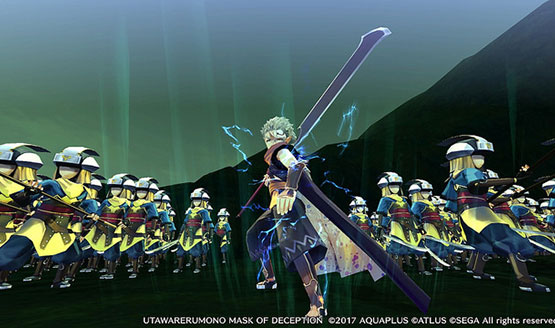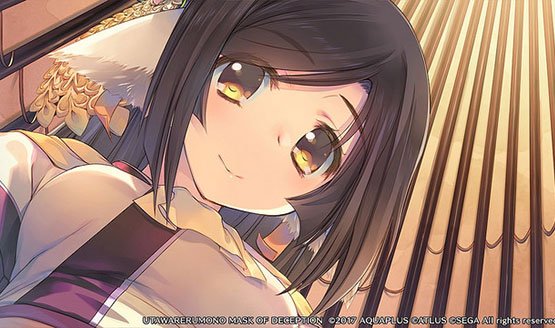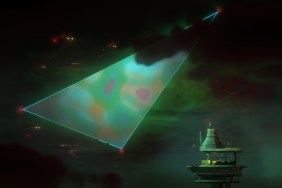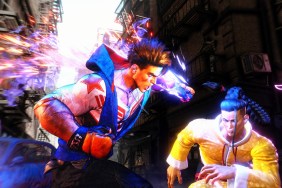Originally launched in Japan in 2015, Utawarerumono: Mask of Deception (or Itsuwari no Kamen in Japan) is the second game of the Utawarerumono series but is the first to get a global release. The first game, simply entitled Utawarerumono, was originally released in Japan back in 2002 for the PC but never got a global release.
Mask of Deception is set several years after the events of the first game and is the first part of a duology which concludes in last year’s Utawarerumono: Futari no Hakuoro (or Mask of Truth for the global release), which will also get a global release this year. Additionally, an anime adaption of Mask of Deception (called The False Faces) was released last year.
While some of the background story for the world of Utawarerumono is showcased in the original game, playing it isn’t completely necessary to grasp the story of Mask of Deception as many of its important history is explained throughout the course of the game as it focuses mostly on building the world and its characters as a setup to the events of its sequel and the second part of the duology, Mask of Truth.

New Beginnings
In Mask of Deception, players take on the role of an amnesiac man rescued a beautiful young girl named Kuon, his eventual companion and guardian. With his memories lost, Kuon decides to name him Haku and takes him under her wing. The duo end up going to the country’s capital, meeting several characters and facing several challenges along the way, where the bulk of the game’s story takes place.
While most of the game’s story consists of introducing players to the game’s world and characters, as it is purposed to be a set up for its sequel, it features some surprising twists and turns that make it all the more interesting and enjoyable. There’s also quite a bit of comedy in Mask of Deception that provides a good contrast to its more serious themes. There are times when the story does start to feel slow and tedious with a few dialogue scenes that feel unnecessary or don’t contribute to either story or character development.
Aside from Haku and Kuon, the game features a large and colorful cast of characters with some great and varying personalities. Some of the characters from the original game have also made a return in Mask of Deception. The large cast does hinder some of the game’s character development though as most of it becomes focused on both Haku and Kuon while the development of the rest of the cast is a bit more minor, although there are enough scenes with all of the characters to help build the game’s story.
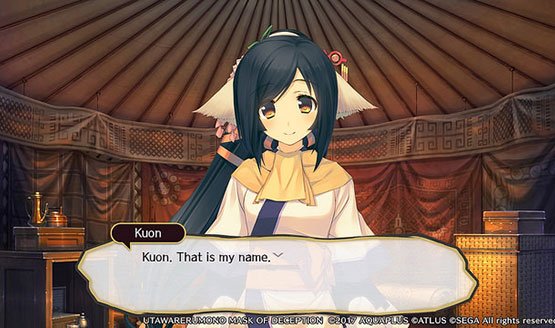
A Straight Line
As the game is primarily a visual novel, most of its content is presented via dialogue. Players will spend most of their time reading text and listening to the voice overs (which is in the original Japanese). There is an Auto mode that players can activate which lets the dialogue play on its own, making the experience less tedious and easier to appreciate. The voice acting in Mask of Deception is also top-notch, even if most people won’t understand it, especially Fujiwara Keiji who plays Haku.
There also isn’t much choice when it comes to partaking of the game’s story. While the game does sometimes give players the option to choose which dialogue scene they’d like to play out first, the order in which the scenes are chosen has no effect on the game’s story or outcome. There are also no dialogue options nor multiple endings in Mask of Deception, making it a purely linear experience.
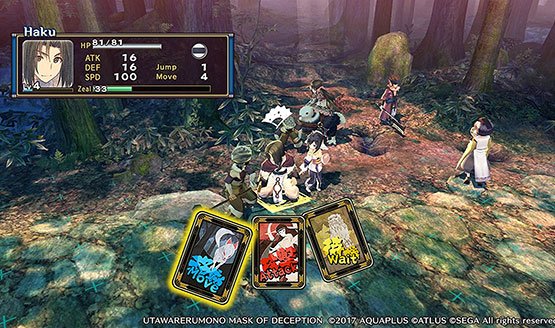
Few and Far Between
Even if the game is classified as a tactical RPG, the game’s battles are few and far between, with most of them occurring near the end of the game. The entirety of the game only features 16 battles throughout its duration and an additional 12 unlock after the main story is finished. In spite of this, the battles are still quite interesting and enjoyable, albeit mostly relatively easy and small in scale.
Mask of Deception’s battles play very much like other tactical RPGS and have very straightforward objectives which either task players to defeat all their opponents or a specific character while losing either all their party members or a specific party member will lead to a defeat. Each battle then begins with players choosing which characters they’d like to include in the battle, pick their starting position, and equip items.
In Mask of Deception players have access to combo or chain attacks. Depending on the ability or attack used, a character will be able to perform multiple attacks on a single opponent in a single turn. When the character performs their attack, players will have to succeed in timing-based mini-games to proceed to the next attack in the chain. Successful chains will make the attack do critical damage as well as proceed to the next attack. If the final chain attack is reached, the character will perform a powerful finishing move. An auto-chain mode is made available for those who would rather skip the mini-games.
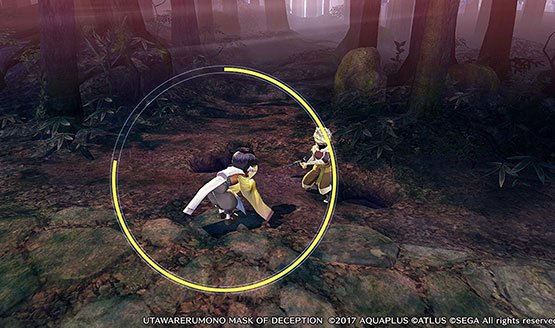
There are also six elements in the game – fire, water, earth, light, and dark – with each character attuned to a specific one, with Haku being the exception as he is non-elemental. Each element is either strong or weak to one other element, which means dealing or taking damage will be affected by the character’s and the enemy’s elemental attunement.
There is also a Rewind feature that allows players to go back to any of the previous turns to redo the battle from that point, allowing players to correct mistakes they’ve made or attempt a different approach. When players suffer a loss, you’re given the option of replaying the entire battle or just rewinding to a previous turn.
Character progression is limited to automatically learning specific skills as they level up, equipping new and more powerful items, and Bonus Points which can be used to increase their basic stats. The character progression doesn’t affect the game’s battles too much though as it is quite possible to finish Mask of Deception without paying much attention to it.
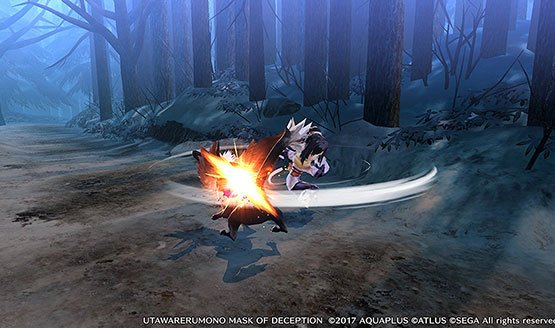
Stark Contrasts
The 3D visuals of Mask of Deception, which are used during the game’s battles and several dialogue scenes, leave a lot to be desired. Both the models and animation all look dated, given that it was also developed for the PS3 and PS Vita, although the stylized design of the characters and monsters fit the game quite nicely.
On the other hand, the still 2D art and character designs are beautiful to say the least. A collaboration of character designer Amazuyu Tatsuki and illustrator Mitsumi Misato, the game’s 2D visuals really bring the game and its characters to life. There is a bit of fan-service in the game of a relatively acceptable quantity that doesn’t affect the telling of its story.
Utawarerumono: Mask of Deception features an interesting story and great cast of characters coupled with excellent 2D visuals and voice acting, making it an easily entertaining experience in spite of its few shortcomings. While those looking for a complex and deep tactical RPG experience may find themselves disappointed, fans of the visual novel genre and the Utawarerumono series will definitely enjoy Mask of Deception and will end up looking forward to Mask of Truth.
Review code for Utawarerumono: Mask of Deception provided by the publisher. Reviewed on PS4. For more information on scoring, please read our Review Policy here.
-
Beautiful 2D visuals
-
Great voice acting
-
Colorful cast of characters
-
Interesting story
-
Dated 3D visuals
-
Story may be too slow for some
-
No story/dialogue choices that affect the story or ending
Utawarerumono: Mask of Deception Review
-
Utawarerumono: Mask of Deception Review #1
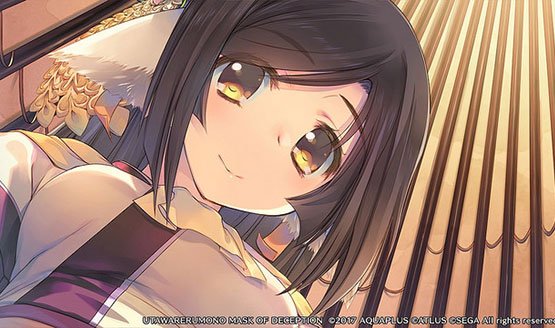
-
Utawarerumono: Mask of Deception Review #2

-
Utawarerumono: Mask of Deception Review #3

-
Utawarerumono: Mask of Deception Review #4

-
Utawarerumono: Mask of Deception Review #5

-
Utawarerumono: Mask of Deception Review #6

-
Utawarerumono: Mask of Deception Review #7
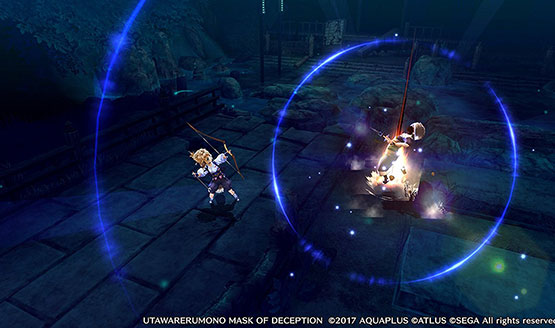
-
Utawarerumono: Mask of Deception Review #8
